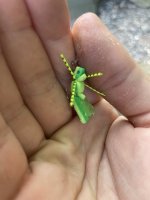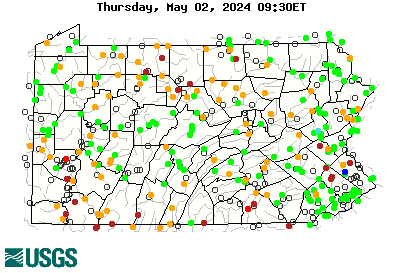ha, the "human light sources"are for the benefit of us humans blundering around in the river at night, not the fish. I'm talking about lights in the distance that can been seen as a glow above the trees, or reflecting off cloud cover. Just enough to provide some night vision. The water itself is dark. There might be some fish species that are attracted to lights, but not smallmouth or largemouth bass, or trout.
Mostly, I fish hair bugs the same way as I do in the daytime- drop it on the water and let it rest for 30 seconds, and then give it a gentle jerk or twitch, sometimes by pointing my rod at the fly and pulling on the line. Be gentle. You want it to act like a frog, a wounded minnow, or a struggling mouse would act in the water. Don't overdo it.
Fish are sensitive, if they're nearby a big bug fly will get their attention when it lands.In fact, if you drop it right on their head, they'll probably take off- unless they're right next to the bank and looking for something to fall in, in which case they'll chomp on it right away. So the way to play things after the fly lands is to give it 30 seconds or so. In still water, enough time for all of the ripples to spread out and disappear. Bass in rivers are not like trout, they're fine with a little bit of current, but they most often hold in pools near structure. River bass swim more than trout. Trout shelter in place, and wait for food to come to them. (The exceptions are big trout feeding at night, which act more like bass. And big hatches, when both trout and bass are known to get reckless.) Bass prefer to prowl, and pounce. They cruise in pools along foam lines, and in the shallows- especially at night. They rarely hold in current that isn't slow enough to have a smooth surface. There are big streches of the Susky, Potomac, and other rivers that are like long, glassy runs, almost from bank to bank. Find the edges of the weed beds, big boulders, sunken logs or other structure. Trout prefer to hug cover. Bass just want some close enough to sprint to in an emergency. In low water, they're spookier than trout.
Figure that the fly landing will attract the fish- so they'll close in to check it out and see if it's maybe something worth eating. If you give the fly action too early, it seems fake. So you want to be just patient enough to let the fish swim over, and then give the fly a little tug, so it quivers in the water. The fun part about topwater bass fishing is that the first little motion is what triggers most of the strikes. But if nothing happens, give it another 10 seconds, twitch the fly again. Do that a couple more times, and then retrieve it slow, at about the speed of a swimming frog. Take your time, because you may have a fish following it, getting ready to pounce. Squeeze the water out of the deer hair and cast again.
When I was a little kid fishing topwater lures like Jitterbugs, I always thought that I had to crank the lure in. Never got a fish like that. If I'd fished it like I was supposed to, the way I just described fishing a fly, I might have caught fish. The trick is to not be impatient. Let the fly or lure rest in the water. And don't strip it in, just move it enough to make it look realistic. A little ripple in the water, and then a pause. The topwater game works much better with flies than lures, actually.







